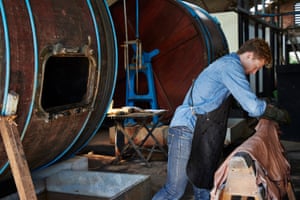Jack Millington walks past two huge industrial-style wooden tanning drums, through a door into the well-insulated drying room. Here, at 35C, amid the whirring of the dehumidifier and one small electric heater, hides from billy goats are stretched out on racks to dry.
Strong yet silky soft to touch, the beauty of the hides lies in the details – from the natural texture of the grain to the spine marks visible down the centre of each pale brown goatskin.
“Every hide is different – these patterns are almost like a fingerprint and that’s exciting to see for the first time as they dry,” says Millington, 31.
Millington’s micro-tannery near Market Harborough in the Midlands is the final step in making full use of the thousands of male or “billy” goats that would otherwise be killed at birth.

Although still dwarfed in size by the dairy cow sector, the UK’s commercial goat-milking herd now numbers around 50,000 animals. The controversy around the killing of male dairy calves at birth has prompted efforts to find markets for the animals. But far less attention has been paid to the male billy goats being killed soon after birth.
The Goat Veterinary Society estimates around 3,000 billy goat kids are slaughtered every year because they are unwanted, with only milk-producing females deemed useful.
One of the few outlets for billies in the UK is goat meat distributor Cabrito, which buys goat meat from dairy farms that keep and rear their billies until around seven months old before slaughter.
But before Millington’s tannery, there had been no outlet for the hides, with goatskins considered a biohazard by abattoirs and mostly incinerated.

Millington came into the industry by accident. Previously working in advertising, he had been trying to help his dairy farmer Dad to find a market for his goat meat when he discovered the masses of goatskins being discarded.
Unable to find a facility that could process smaller, less sought-after goatskins, Millington enlisted experts at the University of Northampton to develop a bespoke tanning recipe using natural bark extracts, then set about creating his own purpose-built micro-tannery.
The tanning process, which takes up to two weeks, starts when the raw hides arrive from the abattoir. They are covered in salt to preserve the skins and draw out moisture, then the traditional “beamhouse operation” begins. Initially, lime powder is added to a small batch of 70 or so skins in the first drum which spins intermittently to remove the hair and plump the skin up into a thick jelly-like material.
Powdered enzyme is then added to break down proteins in the skin and once in the second drum, hides are pickled with rock salt and acid solution. Finally, non-toxic mimosa bark tannins are added to colour the leather overnight.
Once tanned, skins are dyed and finished at a local family-run leather finishing company and handcrafted into luxury bags, wallets, made-to-order shoes and bespoke commissions such as the aprons for staff at SILO, London’s zero waste restaurant.

While most leather companies won’t mention that their fabric comes from livestock, Millington is totally open about the connection between leather and the food industry. All of the billies ultimately used by the tannery come from farms supplying Cheshire-based Delamere Dairy, which processes a third of the UK’s goat milk.
“The leather industry is so misunderstood. People don’t think about where leather comes from, but it’s a natural by-product. The connection between the meat and dairy system and the leather industry has been forgotten, but they are inextricably linked,” says Millington, who launched Billy Tannery three years ago and now sources all his hides from Cabrito.
“We’re repurposing a bi-product that comes from an inherently wasteful food system to make a material that’s biodegradable, natural and beautiful,” he adds.
“It doesn’t do anyone any favours to talk about the males in the dairy system, it’s not in the farmers’ interests, retailers’, or consumers’ interest to dig that much,” explains Cabrito’s founder James Whetlor.

“But if you’re a vegetarian who eats goat’s cheese, you’re directly contributing to a system that euthanises animals at birth, so if you care about the circular economy, the sustainability of industries and reducing the impact of your food on the planet, you should be eating goat meat,” he says.
Sending the hides to Millington’s tannery is the “last piece of the puzzle”, says Whetlor, and ends another unnecessary waste in the goat dairy system.
“200 years ago no one would have dreamt of knocking a perfectly healthy animal on the head at birth, and 100 years ago no one would have dreamt of throwing these hides away. Small artisan production has never had the built-in waste and obsolescence which is part of the modern-day food system,” he says.